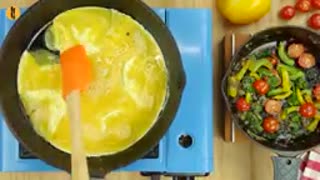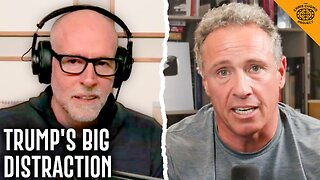Premium Only Content

Personal Protective Equipment (PPE)- Essentials for Food Handlers
### **Personal Protective Equipment (PPE): Essentials for Food Handlers**
Using the right Personal Protective Equipment (PPE) is crucial for food handlers to ensure food safety, maintain hygiene, and prevent contamination. Here’s a guide to the essential PPE every food handler should use:
---
### **1. Hair Restraints**
- **Purpose**: Prevent hair from falling into food or onto surfaces.
- **Examples**: Hairnets, caps, or chef hats.
- **Best Practices**:
- Ensure the entire head and hair are covered.
- For individuals with facial hair, use beard nets.
---
### **2. Gloves**
- **Purpose**: Protect food from hand-borne contaminants, especially during direct contact.
- **Types**:
- **Disposable Gloves**: For single-use tasks like handling ready-to-eat foods.
- **Heat-Resistant Gloves**: For tasks involving ovens or hot equipment.
- **Best Practices**:
- Wash hands before wearing gloves.
- Change gloves between tasks (e.g., after handling raw meat).
- Avoid reusing disposable gloves.
---
### **3. Aprons**
- **Purpose**: Protect clothing and prevent cross-contamination.
- **Types**:
- **Disposable Aprons**: Ideal for handling raw food or high-risk tasks.
- **Washable Aprons**: For regular use in kitchens.
- **Best Practices**:
- Use separate aprons for different tasks (e.g., raw vs. cooked food prep).
- Replace or clean aprons immediately if contaminated.
---
### **4. Footwear**
- **Purpose**: Maintain safety and hygiene in the workplace.
- **Requirements**:
- Non-slip soles to prevent falls.
- Closed-toe designs for protection against spills or dropped items.
- **Best Practices**:
- Clean footwear regularly.
- Designate specific shoes for kitchen use to avoid outside dirt contamination.
---
### **5. Face Masks**
- **Purpose**: Prevent respiratory droplets from contaminating food.
- **Usage**: Mandatory during food preparation, especially in highly regulated environments.
- **Best Practices**:
- Replace masks regularly, especially if damp or soiled.
- Ensure proper fit, covering the nose and mouth completely.
---
### **6. Eye Protection**
- **Purpose**: Protect eyes from splashes, hot oil, or steam during cooking.
- **Examples**: Safety goggles or face shields.
- **Best Practices**: Use during high-risk tasks like frying or cleaning with chemicals.
---
### **7. Sleeves or Arm Guards**
- **Purpose**: Protect arms from burns or chemical exposure.
- **Usage**: Essential for tasks like grilling, oven use, or deep frying.
---
### **8. Proper Clothing**
- **Requirements**:
- Clean, light-colored uniforms to easily spot contamination.
- Long sleeves for additional protection in some environments.
- **Best Practices**:
- Change clothing if soiled or after a shift.
- Avoid wearing personal clothes beneath uniforms.
---
### **9. Ear Protection**
- **Purpose**: Protect ears in noisy environments like large commercial kitchens.
- **Examples**: Earplugs or noise-canceling earmuffs (if necessary).
---
### **10. Maintenance of PPE**
- **Clean Regularly**: Wash reusable PPE (e.g., aprons, footwear) daily or as needed.
- **Inspect for Damage**: Regularly check PPE for wear and tear, and replace damaged items immediately.
- **Store Properly**: Keep PPE in a clean, designated area away from contaminants.
---
### **11. Compliance with Regulations**
- Follow the **Singapore Food Agency (SFA)** guidelines for PPE use in food handling.
- Ensure all PPE is made of food-safe materials and adheres to workplace safety standards.
---
By equipping food handlers with the right PPE and ensuring proper usage, you can minimize contamination risks, maintain hygiene, and promote a safe working environment. Would you like a PPE checklist or training materials for your team?
-
 6:54
6:54
HSESafetyInformation
3 months ago6 Must Try Breakfast recipes By Food Fusion
341 -
 LIVE
LIVE
sKoRpSteR
8 hours ago🔴LIVE RUMBLE GAMING - quick stuff
31 watching -
 4:13:41
4:13:41
The Pascal Show
19 hours ago $0.12 earnedDIDDY TRIAL LIVE! Jane Doe 'Victim #2' Defense CROSS! Diddy Trial Day 20
5.83K -
 DVR
DVR
tacetmort3m
2 hours ago🔴LIVE - VETERAN PLAYER SHOWING HOW ITS DONE - WARHAMMER 40K DARKTIDE
222 -
 LIVE
LIVE
TruthStream with Joe and Scott
14 hours agoSatan and Lucifer part 3, what is the difference? Inversion and Manipulation? A deep dive into an intriguing topic with Ethan Lucas, Restream #441
457 watching -
 2:00:03
2:00:03
MG Show
18 hours agoLA Riots Battle of the Narratives; Optics vs Reality
15.9K17 -
 1:23:40
1:23:40
The Chris Cuomo Project
23 hours agoWhy Scott Galloway Says the LA Protests HELP Trump
5.55K1 -
 58:05
58:05
SinCityCrypto
17 hours ago $0.07 earnedBitcoin Cools off as Ethereum Starts its Run!!
7.21K2 -
 5:31
5:31
Congressman Eli Crane
15 hours agoDNA Profile Hacks Pose SERIOUS Exploitation Risk!
7.7K3 -
 6:11
6:11
John Stossel
21 hours agoThe Extreme Right Goes Woke: How Some "Conservatives" Now Trash Freedom and Praise Karl Marx
14.2K59